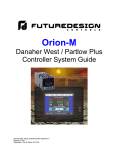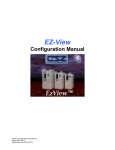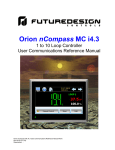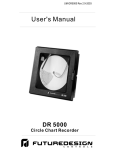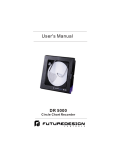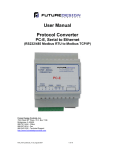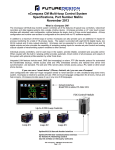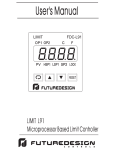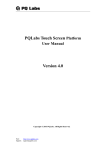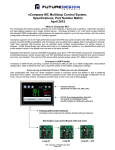Download Orion-M - Future Design Controls
Transcript
Orion-M FDC 100 Series Controller System Guide Orion-M FDC 100 Series Controller System Guide Rev B February 7, 2011 Supersedes: Rev B (March 25, 2010) Orion-M Safety Information in this Manual Notes, cautions and warnings appear throughout this book to draw your attention to important operational and safety information. A “NOTE” marks a short message to alert you to an important detail. A “CAUTION” safety alert appears with information that is important for protecting your equipment and performance. A “WARNING” safety alert appears with information that is important for protecting you, others and equipment from damage. Pay very close attention to all warnings that apply to your application. This symbol (an exclamation point in a triangle) precedes a general CAUTION or WARNING statement. This symbol (a lightning bolt in a lightning bolt in a triangle) precedes an electric shock hazard CAUTION or WARNING safety statement. Technical Assistance If you encounter a problem with your Orion-M controller, review all of your configuration information to verify that your selections are consistent with your application: inputs; outputs; alarms; limits; etc. If the problem persists after checking the above, you can get technical assistance by dialing +1 (866) 342-5332 or by faxing your request to +1 (866) 332-8014, Monday thru Friday, 8:00 a.m. to 5:00 p.m. Eastern Standard Time. You can also email your request to [email protected]. An applications engineer will discuss your application with you. Please have the following information available: • Complete Model #’s and/or Serial #’s for Component(s) in Question • Complete Software Version #’s • All Configuration Information • All User Manuals Warranty and return information is on the back cover of this manual. Your Comments Your comments or suggestions on this manual are welcome. Please send them to: Future Design Controls, P.O. Box 1196, Bridgeview, Illinois, 60455 Telephone: +1 (888) 751-5444; fax: +1 (888) 307-8014 [email protected] The Orion-M FDC 100 Series Controller System Guide is copyrighted by Future Design Controls, Inc., © 2009, all rights reserved (http://www.futuredesigncontrols.com/Orion-M.htm). . FDC Orion-M PREFACE Orion-M 1 What is the Orion-M? ............................................................................................... 1.1 1.1 2 Features............................................................................................................................................... 1.1 Getting Started.......................................................................................................... 2.1 2.1 Installing the FDC 100 Series Controller ............................................................................................. 2.1 2.1.1 Communications Wiring ................................................................................................................ 2.1 3 Configuring the FDC 100 Series Controller............................................................ 3.1 3.1 Assigning the Proper Communications Settings ................................................................................. 3.1 3.2 Input Type Assignments ...................................................................................................................... 3.2 3.2.1 Input 1 Operation .......................................................................................................................... 3.2 3.3 Control Output Assignments ............................................................................................................... 3.3 3.3.1 Auto-Tune and Auto/Manual Operation ........................................................................................ 3.3 3.4 Loop Permissions ................................................................................................................................ 3.4 3.4.1 Set Point Permission Exception.................................................................................................... 3.4 3.4.2 Auto Tune Permission Exception.................................................................................................. 3.4 Appendix Software Usage Note Warranty Returns TABLE OF CONTENTS FDC Orion-M i Orion-M 1 What is the Orion-M? The Orion-M is a multi-loop process control system combined with an embedded SCADA color touch interface. The Orion-M provides a configurable control platform for a variety of OEM applications requiring up to 15 separate loops of control. In addition to 15 loops of control, the Orion-M can also provide up to an additional 15 inputs for process monitoring, for a total of 30 process inputs. The system is provided with eight 24Vdc digital inputs, two 24Vdc outputs and 6 relay outputs standard. The Orion-M can be expanded to a total of 16 digital inputs and 32 digital outputs. The Orion-M also provides the capability of accepting analog inputs for remote set point control and analog outputs capable of retransmitting system variables (PV, SP or %Out) to other devices such as a chart recorder. The 0-10Vdc or 4-20mA user selectable signals are provided through the addition of optional analog expander cards. The Orion-M complements its versatile hardware platform by providing a host of standard features and configuration capabilities, all through its visual, touch interface. The touch screen interface is an embedded, industrial PC with all software included. No external PC software is required for setup or configuration of the Orion-M. All of the setup and configuration data is saved to the Orion-M’s internal memory. Individual process controllers, one for each loop in the system, provide reliable, consistent and accurate control by distributing the process control requirements of the system among multiple processors. Each loop controller provides full auto tune functionality with high resolution, universal process inputs. When coupled with the built in ramping profiler of the Orion-M, it allows for automatic, timed control of all processes and outputs of the system. No other control system on the market provides the flexibility, functionality and configurability of the Orion-M. 1.1 Features The digital inputs of the Orion-M can be configured as alarm inputs with adjustable delay timers, as control inputs for controlling profile operation or for direct control of the system’s digital outputs. The digital outputs of the Orion-M can be used as direct outputs for controlling external equipment related to the application through software switches, called events, or be programmed to act as system alarm or status outputs. All outputs have adjustable delay times for on, off and cycle times. The Orion-M can be operated in single set point or automatic profile control mode. Profile entry is made easy through the use of copy, paste and delete menu selections. Profiles can be copied to the external ‘USB’ memory stick and then imported to another Orion-M controller which eliminates the need to enter duplicate profiles into multiple Orion-M systems. When running in automatic profile mode, the operator can place the system into hold and change any control parameter without modifying the saved profile. This gives the operator maximum flexibility over the controlled process. Data file analysis tools (auto-trend) make looking at historical data a simple task. Any control variable saved to the Orion-M flash memory can be plotted on the historical data trend, for any time frame within the data file’s total time range. Full ‘USB’ print capabilities from the Orion-M interface to a standard HP inkjet printer Model 6540, 6940, 6980 (or compatible printer), eliminates the need for a PC, strip or circular chart-recording device. Graphics trends, historical and report print functions are standard. The built in Ethernet functionality includes a ‘Web Server’ to provides access to all Orion-M data (view only), a VNC interface for remote control and monitoring and an NTS clock, all available via a local Intranet connection (wired or wireless), or the World Wide Web using standard software like Microsoft’s Internet Explorer. WHAT IS THE ORION-M? FDC Orion-M 1.1 Orion-M The Orion-M provides a rich set of tools for control interaction and data analysis. Views include system overviews, trends, alarms, profiles as well as historical data, alarm history and audit trail views. The menu driven interface eliminates screen ‘clutter’ by providing an easy to use ‘Windows’ interface for interaction between the user and the Orion-M system. The Orion-M can store more than one year of data on its internal compact flash card. Data logging can be enabled manually or automatically during automatic profile run. Data backup is provided with the ‘USB IStick’ for plug and play transfer of files to any PC running Microsoft Windows XP operating systems. The Orion-M security module provides full system security with three levels of access. Each of the three access levels allow for independent user rights. Up to 30 users can be entered into the system while the audit trail tracks all operator actions and records them. The Orion-M control system includes the following interface features: • • • • • • • • • • • • • • • • • • 1.2 Overview screen that displays all “runtime” information. Profile run and monitor views. Profile entry, open, save and download interface screens. Current alarm and alarm history views (alarm history for up to 1 year). Real time trends (with adjustable X,Y limits) for all inputs. System and application setup (control loops, monitors, inputs/outputs, alarms, etc.). Data logging interface screens include log point selection and historical viewing. ‘Plug and Play’ memory stick functionality for data transfer/backup. Full USB print capabilities and on-line help screens Web server for intranet/internet access (view only). VNC server for intranet/internet access (control/view). FTP data back-up for automatic data file transfer over intranet/internet. Integrated email server for alarm notification and file transfer. NTS clock with daylight savings time insures that the system is up to date. Full security with audit trail for tracking user actions. Maintenance counters for output cycles and on times. Helps screens are available for most screen views; configurable in English, Spanish and French Voice assisted help in English, Spanish and French (external speakers required – not included). FDC Orion-M WHAT IS THE ORION-M? Orion-M 2 Getting Started The Orion-M requires one FDC 100 Series for each control loop required in the system. Since the Orion-M is capable of interfacing to more than one brand of controller, refer to the Orion-M part number matrix for the operating system to be sure that the FD10, CM application software has been provided. The Orion-M will not operate correctly if any other version of CM application software is used with an FDC 100 Series controller. 2.1 Installing the FDC 100 Series Controller For applications requiring several loops of control or more, proper planning and arrangement of the 100 Series controllers prior to mounting is critical for optimum routing of the controller wiring. For applications requiring frequent access to the controllers, panel mounting provides direct access. For applications where operator access to the controllers is not required, or is desired to be kept at a minimum, the controllers can be mounted directly inside of an enclosure. This also reduces wiring concerns by eliminating the need to run the sensor, communication and control wiring for each controller to and from an enclosure door. Refer to the user’s manual for the 100 Series control being used for dimensions, appropriate mounting and operating conditions, including proper electrical connections. Connect sensor and control wiring as required, paying close attention to all wiring precautions and guidelines as noted in the controller manual. It is recommended that all sensor and communication wiring, to and form the 100 Series controllers, be routed away from all high voltage and/or output control wiring. This will minimize the chances of electrical transients or spikes in the power/control wiring from causing communications or sensor reading errors. 2.1.1 Communications Wiring Each FDC 100 Series control used in the Orion-M system is its own independent loop control. However, in order for the controllers to work as part of the system, they must communicate with the Orion-M control module using RS485 serial communications. Therefore, each 100 Series used must be equipped with the RS485 communications option or they will not operate as part of the Orion-M system: FDC-9100- X X X X X 1 FDC-8100- X X X X X 1 X FDC-4100- X X X X X 1 X Order code 1 designates RS-485 Modbus RTU serial communications (see particular 100 Series User’s Manual for order code descriptions) Communications wiring must be run using a minimum of 24 AWG twisted-pair, copper conductors. For short runs (< 50 feet total), non-shielded wiring can be used as long as proper separation from power/control conductors is maintained. For communications wiring where the total length will exceed 50 feet, up to the maximum allowed length of 650 feet, shielded twisted-pair must be used. NOTE: FDC recommends the use of shielded wire for all installations regardless of the total length in order to maintain optimum performance and minimize the possibility of communications errors. When using shielded twisted-pair, be sure to ground the shield at only one end, preferably at the Orion-M control module. Allowing any other portion of the cable shield to come in contact with ground, or grounding both ends, will allow ground loop currents to flow in that section of the cable shield which can disrupt communications. GETTING STARTED FDC Orion-M 2.1 Orion-M Communications Wiring Example (FDC-9100 controller shown) Communications wiring to the FDC8100/4100 series are identical to that as shown above for the FDC-9100 controller except the terminals are in a different location. NOTE: 2.2 Refer to the User’s Manual for the 100 Series controller used for all other connections including power, sensor and control wiring. Since no two applications are the same, it is up to the system designer to insure that the controllers are properly installed and wired to meet design specifications. FDC Orion-M GETTING STARTED Orion-M 3 Configuring the FDC 100 Series Controller The unique and inherently flexible design of the Orion-M system allows the OEM to tailor each component of the system to the application. By using independent loop controls, each one can be configured for various input and output types, control algorithms, etc., based on the requirements of the application. It also allows control loops to be added or replaced on the system at any time, simply by connecting the controller to the Orion-M’s control module, RS-485 communication link. If the application requirements change and a different input or output type is required, or if the controller were to fail, it can be replaced quickly, and at a lower cost as compared to having to repair or replace larger, integrated multi-loop controllers. The Orion-M only requires that the communications settings for each loop control be properly assigned, and that the input type of the controller is set in the Orion-M Configurator, so that the control loop input and set point can be displayed and set properly through the Orion-M interface. 3.1 Assigning the Proper Communications Settings The Orion-M can support up to 15 FDC 100 Series controls. They can be mixed and matched as required, but each one must have its own communication address. The allowable address range is 1 – 15 corresponding to Loop Input #1 – 15 in the Orion-M Configurator. Communication addresses must be assigned to all controllers on the communications link beginning with 1, up to the total number of controllers. As control loops are enabled in the Orion-M Configurator, the Orion-M will automatically use the Loop Input # as the corresponding controller address. If more than one 100 Series controller has the same address, or a loop input is enabled but a controller is not assigned to that address, the Orion-M will report a communications alarm for that loop input when the runtime application is started. NOTE: The order of the loop controls on the communication link is not important. The communications address for a controller can be assigned regardless of its position on the link. In addition to the communications address, the baud rate, data bits, stop bits and parity settings must also be set to match the control module of the Orion-M. The Orion-M uses the factory default communication rate of 9600 baud, 8 data bits and 1 stop bit; however, the parity of the 100 Series controller must be changed from the factory default of ‘even’ to ‘none’. In addition to the communication parameters, the lock function level of the control must be set to ‘nonE’. This permits the Orion-M’s control module to access the necessary data values within the 100 Series Control. If the lock function level denies access to any of the 100 Series parameters, communication errors will result. *Required 300 Series Controller Settings for Proper Communications: • • • • • • • Function complexity level (Lock): Communication interface type (Conn): Address assignment of digital COMM (Addr): Baud rate of digital COMM (bAud): Data bit count of digital COMM (dAtA): Parity bit of digital COMM (PAri): Stop bit count of digital COMM (StoP): nonE rtu 1-15 (based on system design) 9.6 8bit none 1bit *See section 1-5 Menu Overview, in the 100 Series User’s Manual for instructions on accessing the control’s Setup Menu and setting the above parameters as required. CONFIGURING THE FDC 100 SERIES CONTROLLER FDC Orion-M 3.1 Orion-M 3.2 Input Type Assignments The FDC 100 Series controls offer a universal thermocouple/RTD input option or various linear input options for different voltage and current ranges. The Loop Input # for the corresponding control in the Orion-M Configurator is set to match the selected input type of the 100 Series control. Based on this selection, the Orion-M assumes control of certain parameters related to the input and automatically assigns them based on settings made in the Orion-M. 3.2.1 Input 1 Operation When input 1 of the 100 Series control is set for a temperature input type, i.e., RTD or thermocouple, the corresponding Loop Input # in Orion-M Configurator must also be set to temperature. When these selections are made, the Orion-M will automatically set the temperature units of the control to match the temperature units (degrees C or F) set in the Orion-M. If the Orion-M loop input type is set to process in the Configurator for a temperature input type, the Orion-M will change engineering units for the input; however, the units in the 100 Series control will not be set to match by the Orion-M. Therefore, the Orion-M may display units in degrees Fahrenheit while the reading is in degrees Centigrade or vice versa. When input 1 of the 100 Series control is set for a linear input type, i.e., voltage or current, the corresponding Loop Input # in Orion-M Configurator must be set to process even if the input is from a temperature transmitter. The range and units of the temperature transmitter are unknown to the Orion-M so they must be manually set at the 100 Series control. If the Orion-M loop input type is set to temperature in the Configurator for a linear input type, the Orion-M will change engineering units for the input; however, the measurement will not change. Therefore, the Orion-M may display units in degrees Fahrenheit while the reading is in degrees Centigrade or vice versa. For either temperature or linear input types, the Orion-M will set the decimal point and lower and upper set point limits for the input to match the settings in the Configurator. The decimal point and set point limits must match in order for the system to operate properly and display the correct values on the Orion-M interface. IMPORTANT: The temperature units, decimal point and lower and upper set point limits are set once, each time the Orion-M enters the runtime application. Do not alter the values in the 100 Series control once they have been set or the Orion-M will not display the correct process value or set the correct set point to the loop control which could result in a runaway condition leading to property damage or injury to personnel. 3.2 FDC Orion-M CONFIGURING THE FDC 100 SERIES CONTROLLER Orion-M 3.3 Control Output Assignments The 100 Series controls have two control outputs that can be assigned to operate as heat/cool (indirect/direct). If only a single control output is used (output 1), for heating or cooling operation, the Orion-M will display a percentage of output of 0.0 – 100.0% for the output. If both outputs are used in a heat/cool application (output 1 is heat and output 2 is cool), the Orion-M will display a value of -100.0% to 100.0% for the percentage of output. In this case, 0.0% represents both heat and cool outputs are off. Values from 0.0 to 100.0% represent the percentage of heat output from off to full on and values from 0.0 to -100.0% represent the percentage of cool output from off to full on. NOTE: Output 2 of the 100 Series controller can be configured to act as an alarm output. If configured as an alarm output, it will cause the Orion-M to report an incorrect percentage of output reading when the alarm output is active. When the output is on, it will cause an offset of -100% in the percentage of output reading shown on the Orion-M. For example, if control output 1 is at 50% power, and output 2 is activated as an alarm, the Orion-M will report an output of -50% (50-100). If output 1 is at full output power and output 2 is activated, the Orion-M will report an output percentage of 0% (100-100). Therefore, even though control output 1 is on, the Orion-M will report the output as being off. When output 2 is off, no offset will be applied to the control output percentage of output reading. Thus, to prevent operator confusion, it is recommended that output 2 not be used for an alarm output function. It should be set to ‘nonE’ or used for cooling operation (CooL) only. If an alarm output is required, the 100 Series control should be fitted with the alarm 1 output option. 3.3.1 Auto-Tune and Auto/Manual Operation The Orion-M provides the ability to switch each 100 Series control in the system between auto and manual output operation as well as initiating the controller’s auto-tune function. These functions are accessed from the Orion-M runtime, Single Loop View screen via the ‘AM’ and ‘AT’ control buttons. As long as the output is not programmed for on/off control, i.e., the proportional band is set to zero (0), these functions will be available. If the proportional band of the control’s PID parameters is set to zero; however, the auto-tune and auto/manual selections will be disabled. NOTE: Output 2 of the 100 Series controller can be configured to act as an alarm output. If configured as an alarm output, its operation will be overridden when the controller is put into manual mode. If the alarm output is required to operate even when the controller is put into manual mode, output 2 can not be used as an alarm output. The 100 Series controller must be fitted with the alarm 1 output option. CONFIGURING THE FDC 100 SERIES CONTROLLER FDC Orion-M 3.3 Orion-M 3.4 Loop Permissions The Orion-M iSeries configuration provides permissions which can be set to allow the control loop set point, auto/manual and auto tune operations to be performed at the loop control itself as well as through the OrionM. These can allow an operator to make changes at the loop control in cases where the Orion-M interface is located in a remote location. 3.4.1 Set Point Permission Exception If the control loop is configured to operate under cascade control or is configured as an RH wet bulb loop type, the set point for the loop is generated by logic within the Orion-M. The loop will not function as configured unless the se point is constantly set by the Orion-M. Thus, any change made at the loop control will be overridden by the Orion-M. If local adjustment at the loop control may be required for any reason, loop set point communications must be interrupted via a digital input to the Orion-M configured as ‘loop SP comms disable’. 3.4.2 Auto Tune Permission Exception If the control loop is configured to operate under cascade control or is configured as an RH wet bulb loop type, the set point for the loop is generated by logic within the Orion-M. This set point may constantly fluctuate in order to provide the proper control action. The 100 Series controller will abort the auto tune process if its set point is changed while it is auto tuning. Thus, if auto tune is initiated at the loop control and the Orion-M is sending a new set point, the auto tune will be immediately aborted. When auto tune is activated at the Orion-M, the set point is first ‘locked in’ prior to initiating the auto tune. This prevents the set point from being changed if the loop is a wet bulb type or under cascade control once auto tune is activated. The Orion-M will maintain the current set point at the loop control regardless of process changes until the auto tune completes. 3.4 FDC Orion-M CONFIGURING THE FDC 100 SERIES CONTROLLER Orion-M Appendix APPENDIX FDC Orion-M A.1 Orion-M Software Usage Note: The selection, application or use of Future Design Control products or software is the purchaser or user's responsibility. No claims will be allowed for any damages or losses, whether direct, indirect, incidental, special or consequential. In addition, Future Design reserves the right to make changes without notification to purchaser or user to materials or processing that do not affect compliance with any applicable specification. Future Design makes no warranties when using the Orion-M system. Warranty: Future Design Controls products described in this book are warranted to be free from functional defects in material and workmanship at the time the products shipped from Future Design Controls facilities and to conform at that time to the specifications set forth in the relevant Future Design Controls manual, sheet or sheets for a period of one year after delivery to the first purchaser. Future Design Controls products are warranted to be free from functional defects in materials and workmanship at the time the products shipped from Future Design Controls facilities and to conform at that time to the specifications set forth in the relevant Future Design Controls manual, sheet or sheets for a period of one year after delivery to the first purchaser for use. There are no expressed or implied Warranties extending beyond the Warranties herein and above set forth. Limitations: Future Design Controls provides no warranty or representations of any sort regarding the fitness of use or application of its products by the purchaser. Users are responsible for the selection, suitability of the products for their application or use of Future Design Controls products. Future Design Controls shall not be liable for any damages or losses, whether direct, indirect, incidental, special, consequential or any other damages, costs or expenses excepting only the cost or expense of repair or replacement of Future Design Control products as described below. Future Design Controls sole responsibility under the warranty, at Future Design Controls option, is limited to replacement or repair, free of charge, or refund of purchase price within the warranty period specified. This warranty does not apply to damage resulting from transportation, alteration, misuse or abuse. Future Design Controls reserves the right to make changes without notification to purchaser to materials or processing that do not affect compliance with any applicable specifications. Return Material Authorization: Contact Future Design Controls for Return Material Authorization Number prior to returning any product to our facility: 7524 West 98th Place – Bridgeview, IL 60455 – Phone 888.751.5444 – Fax 888.307.8014 http://www.futuredesigncontrols.com A.2 FDC Orion-M APPENDIX














